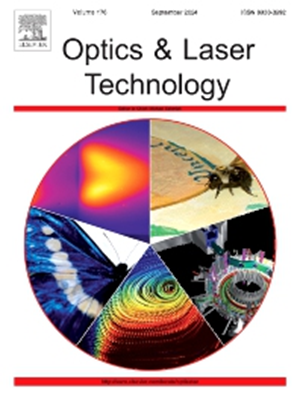基于多向导数联合对比度的红外小目标检测
IF 4.6
2区 物理与天体物理
Q1 OPTICS
引用次数: 0
摘要
红外图像中的小目标检测在红外搜索和预警应用中起着至关重要的作用,近年来已成为计算机视觉领域的研究热点。然而,许多现有的方法主要依赖于单特征表示,这限制了它们在处理涉及边缘和角落等混乱区域的复杂场景时的有效性。为了克服这一局限性,本研究提出了一种基于多向导数联合对比度测量(MDCM)的红外小目标检测新方法。首先,利用facet模型推导红外图像的多向二阶导数(MSOD),在MSOD域中分析目标与背景干扰的对比度特征。利用小目标固有的二阶导数特征,开发了一种导数显著性度量加权峰值差(DSMWPD)来减轻明显的边缘和角伪影的影响。此外,考虑到小目标的近似各向同性特性,设计了一种局部对比度量加权交叉不相似度(LCMWCD),利用多向对比不相似度作为惩罚来抑制强烈的结构化杂波,进一步强调目标区域。通过将输出相乘组合得到最终的显著性图,然后进行自适应阈值提取目标。实验验证表明,该方法在各种具有挑战性的背景条件下检测红外小目标具有优越的精度和鲁棒性,优于几种当代最先进的算法。本文章由计算机程序翻译,如有差异,请以英文原文为准。
Infrared small target detection via multidirectional derivative joint contrast measure
Detecting small targets in infrared imagery plays a crucial role in infrared search and early warning applications, and has recently become a research hotspot within the field of computer vision. However, many existing approaches predominantly rely on single-feature representations, which limits their effectiveness when dealing with complex scenes involving cluttered regions like edges and corners. To overcome this limitation, the present research introduces a novel method for detecting small infrared targets based on a multidirectional derivative joint contrast measure (MDCM). Initially, a facet model is used to derive the multidirectional second-order derivatives (MSOD) of the infrared image, enabling analysis of contrast characteristics between targets and background interference in the MSOD domain. Leveraging the distinct second-order derivative features inherent to small targets, a derivative saliency measure weighted peak difference (DSMWPD) is developed to mitigate the influence of pronounced edges and corner artifacts. Additionally, acknowledging the approximately isotropic nature of small targets, a local contrast measure weighted cross-dissimilarity (LCMWCD) is designed, which applies multidirectional contrast dissimilarities as penalization to suppress intense structured clutter and further emphasize target regions. The final saliency map is obtained by combining the outputs multiplicatively, followed by adaptive thresholding to extract the targets. Experimental validation demonstrates that the proposed approach achieves superior accuracy and robustness in detecting infrared small targets across various challenging background conditions, outperforming several contemporary state-of-the-art algorithms.
求助全文
通过发布文献求助,成功后即可免费获取论文全文。
去求助
来源期刊
CiteScore
8.50
自引率
10.00%
发文量
1060
审稿时长
3.4 months
期刊介绍:
Optics & Laser Technology aims to provide a vehicle for the publication of a broad range of high quality research and review papers in those fields of scientific and engineering research appertaining to the development and application of the technology of optics and lasers. Papers describing original work in these areas are submitted to rigorous refereeing prior to acceptance for publication.
The scope of Optics & Laser Technology encompasses, but is not restricted to, the following areas:
•development in all types of lasers
•developments in optoelectronic devices and photonics
•developments in new photonics and optical concepts
•developments in conventional optics, optical instruments and components
•techniques of optical metrology, including interferometry and optical fibre sensors
•LIDAR and other non-contact optical measurement techniques, including optical methods in heat and fluid flow
•applications of lasers to materials processing, optical NDT display (including holography) and optical communication
•research and development in the field of laser safety including studies of hazards resulting from the applications of lasers (laser safety, hazards of laser fume)
•developments in optical computing and optical information processing
•developments in new optical materials
•developments in new optical characterization methods and techniques
•developments in quantum optics
•developments in light assisted micro and nanofabrication methods and techniques
•developments in nanophotonics and biophotonics
•developments in imaging processing and systems

 求助内容:
求助内容: 应助结果提醒方式:
应助结果提醒方式:


